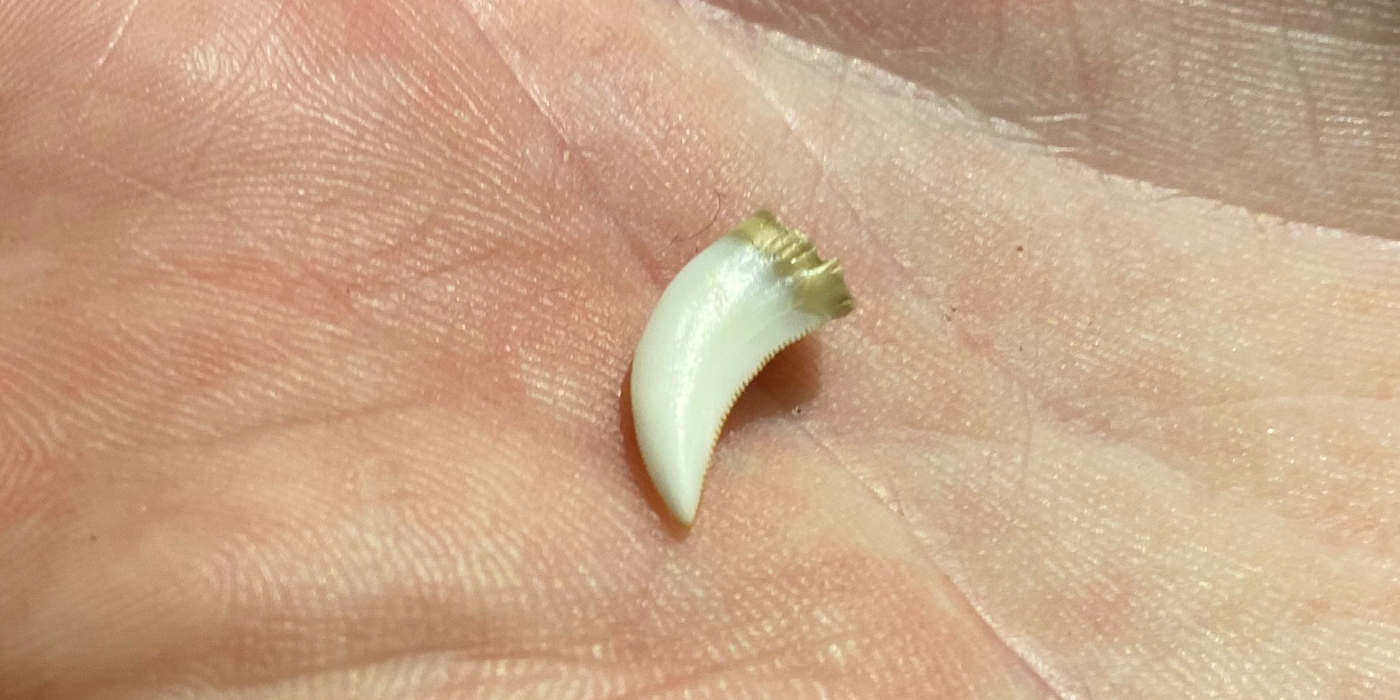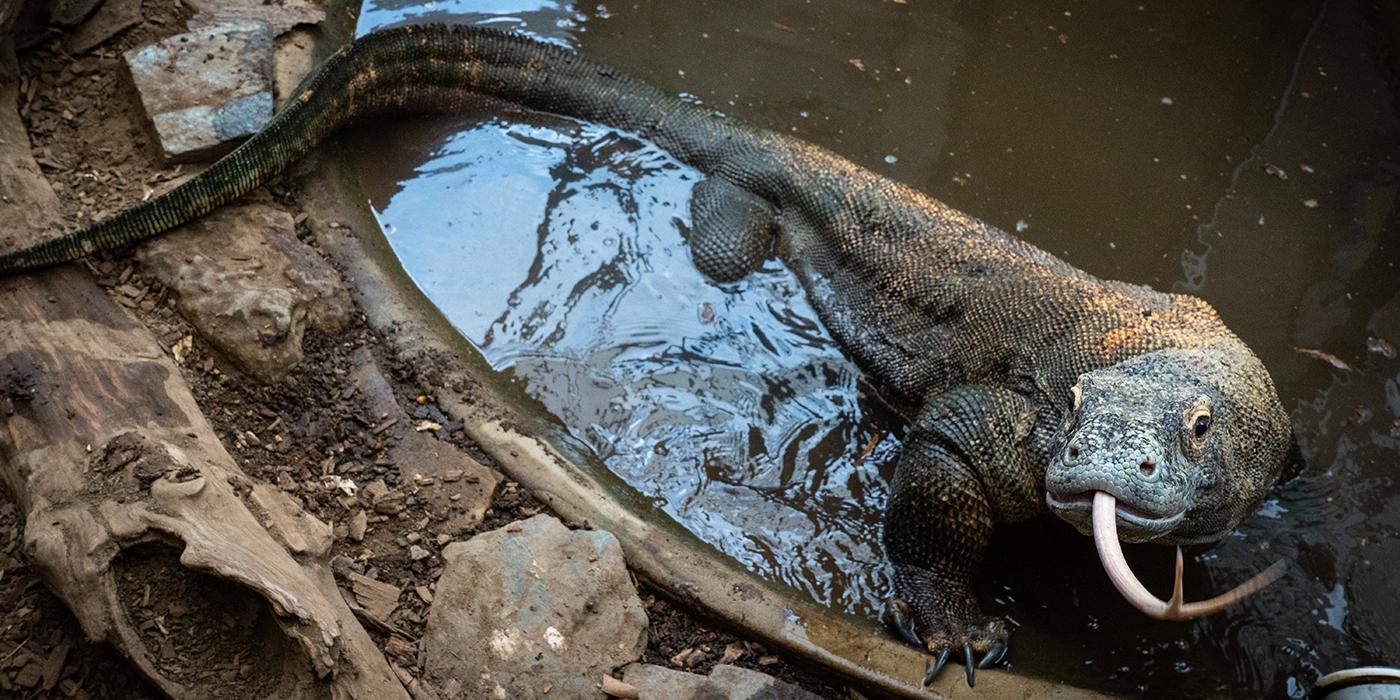How Dangerous Are Komodo Dragons? And Other Komodo Dragon Facts

Thanks to their thick skin, strong claws, sharp teeth, and painful bite, Komodo dragons are NOT an animal you'd want to mess with.
Are Komodo dragons really dragons?
Depends on how you look at it. Dragons in European mythology are huge, fire-breathing creatures with tough scales. In Eastern cultures, dragons are usually thought of as serpent-like beings that bring good luck or prosperity and can sometimes control the elements.
Komodo dragons aren’t magical creatures or mighty spirits. They’re reptiles— and with thick, leathery skin, strong claws, sharp teeth, and a painful bite, they come pretty close to what a "real" dragon might be like.
How dangerous are Komodo dragons?
An attack from a Komodo dragon can be fatal—even to humans.
Compared to crocodilians and other reptiles, Komodo dragons have relatively weak bite strength. Instead, they rely on their sharp, curved teeth and long, sturdy claws to slash and tear at their prey with astonishing force. After biting down, they use their powerful neck muscles to violently shake side-to-side, ripping apart flesh and muscle and causing severe blood loss and shock.
Any prey manages to escape an attack might not consider themselves lucky for long. A Komodo dragon’s killing power is intensified by a combination of secondary weapons: venom and bacteria. The sharp, serrated shape of a Komodo dragon’s tooth makes it easy for bits of rotten flesh to get caught in the reptile’s mouth, turning their saliva into a mini-habitat for harmful bacteria that can cause untreated bite wounds to become septic. Researchers have also documented a venom gland in the dragon's lower jaw. This venom prevents their prey’s blood from clotting, which causes massive blood loss and induces shock. Even larger prey animals like water buffaloes may succumb to their wounds after escaping an initial attack—although it may take days for that to happen.
What do Komodo dragons eat?
Komodo dragons are carnivores. A big part of a Komodo dragon’s diet is carrion, or decaying flesh from dead animals. But they are fully capable of hunting live prey, and there are recorded instances of fully-grown Komodo dragons taking down animals as large as horses and water buffaloes.
Young individuals feed primarily on small lizards and insects, as well as snakes and birds. When they get older and grow bigger, they move onto larger prey, such as rodents, monkeys, goats, wild boars and deer (their preferred meal).

What eats a Komodo dragon?
Larger Komodo dragons!
When they first hatch, Komodo dragons weigh less than 3.5 ounces (100 grams) and average 16 inches (40 centimeters) in length—about the same size as a pair of crew socks. As a result, they are at risk for cannibalistic attacks from adult members of their species.
They spend much of the first few years living in trees, where larger Komodo dragons cannot reach them. At around 5 years of age, young Komodo dragons are large enough to fend for themselves and live a more terrestrial lifestyle.
What’s the difference between a Komodo dragon and a monitor lizard?
Found throughout warm regions of Africa, Asia and Australia, monitor lizards are a family of lizards known for their long necks, sharp claws and powerful limbs. Komodo dragons are the largest member of the monitor family.
Just how big are Komodo dragons?
Adult Komodo dragons are among the largest, heaviest lizards on Earth. In the wild, these scaly giants usually weigh around 154 pounds (70 kilograms). The largest verified specimen reached a length of 10.3 feet (3.13 meters) and weighed 366 pounds (166 kilograms), which is as long as a small car and as heavy as a refrigerator.
A Komodo dragon’s stomach expands easily, enabling an adult to consume up to 80 percent of its own body weight in a single meal!
Where do Komodo dragons live? Where can I see one in real life?
In the wild, their range is limited to just a few small Indonesian islands, including Rintja, Flores, and of course, the island of Komodo, the largest at 22 miles (35 kilometers) long. They can be found in tropical forest, grassland and scrubland habitats on these islands.
Ever since the first Komodo dragons were born outside of Indonesia under care of the Smithsonian's National Zoo and Conservation and Biology Institute in 1992, reptile experts at zoos and wildlife centers around the world have learned more about how to help these magnificent animals thrive in human care.
You can see Komodo dragons at accredited zoos throughout the United States. At the Smithsonian's National Zoo in Washington, D.C., visitors can see two male Komodo dragons named Murphy and Onyx.
Are Komodo dragons endangered?
Yes, Komodo dragons are endangered. Scientists estimate there are less than 1,400 individuals in the wild.
One major threat to their long-term survival is habitat loss—parts of their native sea islands are expected to submerge in the next century due to the effects climate change. Also, human encroachment and overhunting of deer and other prey animals are making it harder for Komodo dragons to thrive in their habitat.
How can I help Komodo dragons?
Komodo dragons are a protected species. A large portion of their habitat area is included within Komodo National Park, founded by the Indonesian government in 1980 for the protection of Komodo dragons and their habitat. Strict anti-poaching laws have also helped protect these animals from being hunted and killed, although illegal activity still takes place.
Want to help? You can be part of the solution. Get involved with local zoos and other organizations that research the care of Komodo dragons and other threatened animals. Or consider donating to wildlife conservation organizations that protect Komodo dragons and the habitat areas they rely on. Practice ecotourism by being an advocate for the environment when you’re on vacation. And finally, shop smart. Avoid buying products made from animals, which removes the incentive for poachers and illegal wildlife traders to harm endangered species.
Stop by the Reptile Discovery Center to see Murphy and Onyx during your next visit to the Smithsonian's National Zoo.
BONUS CONTENT! Find out how the Smithsonian's National Zoo cares for a Komodo dragon with arthritis in this video.
Related Species:
